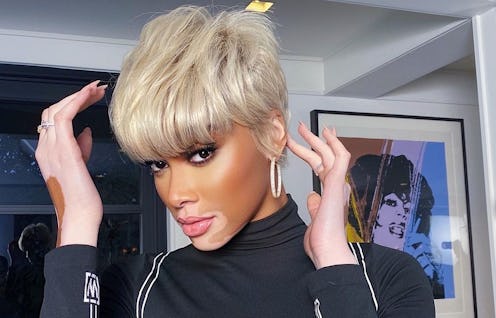(Beauty)
3 Things No One Tells You About Getting A Pixie Cut

There comes a time in most people's lives when they begin to ask themselves, should I get a pixie cut? For me, the answer was a resounding yes. I first cut off my hair during college, growing it out and snipping it all off multiple times since. Typically whenever my thick and wavy hair becomes too annoying to style or I feel like I need a change, though like many, I was first convinced that having a pixie would be so much easier to handle.
Spoiler alert: it's not. While I'm convinced that short hair looks great on everyone — it's so dramatic, and makes it that much more fun to play around with bold makeup — cowlicks, runaway curls or flyaways, and scalp maintenance become top-of-mind tasks once you go short. "Often times, people are interested in getting pixie cuts because they are easy to take care of in terms of overall maintenance," explains Sally Hershberger over email, a salon owner and celebrity hairstylist whose clientele has included Miley Cyrus, Nicole Kidman, Meg Ryan, and many more. "However, while it may take less time to dry and style, it does require some upkeep."
That said, if you're contemplating a pixie cut for yourself, I say go for it — but make sure you know what you're getting into first. Ahead, everything first-timers should know before cutting off all their hair.
We only include products that have been independently selected by The Zoe Report’s editorial team. However, we may receive a portion of sales if you purchase a product through a link in this article.
Maintaining A Pixie Cut Requires Work
Stretching out the time between haircuts when you have a longer style is very different than putting off a salon visit once you have a pixie. A structural pixie shape can quickly verge on mullet territory before you realize it, and the shorter layers reveal imperfections — think unwanted growth, uneven layers, or runaway cowlicks — since there's less room to hide.
"In order to preserve the hairstyle, clients generally have to come in every four to six weeks to maintain the shape," adds Hershberger. After all, the shape of the pixie itself is key here. Hershberger notes the importance of your stylist constructing a pixie that complements your own features, "as a good pixie cut will highlight them. For example, a pixie with bangs is a great way to enhance beautiful eyes since it will draw attention there."
Pixie Cut Styling Products Are A Must
I air-dry my hair, using very few styling products when it's long, and figured my low-maintenance hair routine would translate just fine for a pixie cut. I found out the very first time I cut my hair that I was wrong, and have been reminded each time since how necessary it is to invest in short hair styling products. When my hair's short, it can actually become too volumized for the shape I want, so I end up having to smooth it down with oils, mousse, or hairspray, then re-texturize for a piece-ier finish.
"For individuals with coily or curly hair that are interested in a pixie cut, it’s important to work with natural hair texture to create a shape that is sustainable in terms of styling. By following the natural growth of hair and playing around with different styles, such as baby bangs and brushed-out curls, you and your stylist can align on a shape that works best for your hair and that enhances your facial features," says Hershberger. "I also recommend asking your hairdresser for tips on how to properly style it so you will know how to style at home."
Care For Your Scalp When You Have A Pixie Cut
Flakes, buildup, grease — anything along your scalp ends up on display without longer hair there to help conceal it. One of my least favorite downsides of a pixie cut, this actually helped teach me the importance of scalp care in a hair care routine, a lesson that's smart to understand regardless of hair length.
For some, it might be as easy as incorporating a cleansing scalp treatment, while others will need to find a shampoo or conditioner that counteracts flakiness before it starts. I'm in the latter party, though have had success with tea tree oil for my scalp. (The Paul Mitchell Tea Tree Scalp Care Anti-Thinning shampoo and conditioner work wonders.)
This article was originally published on